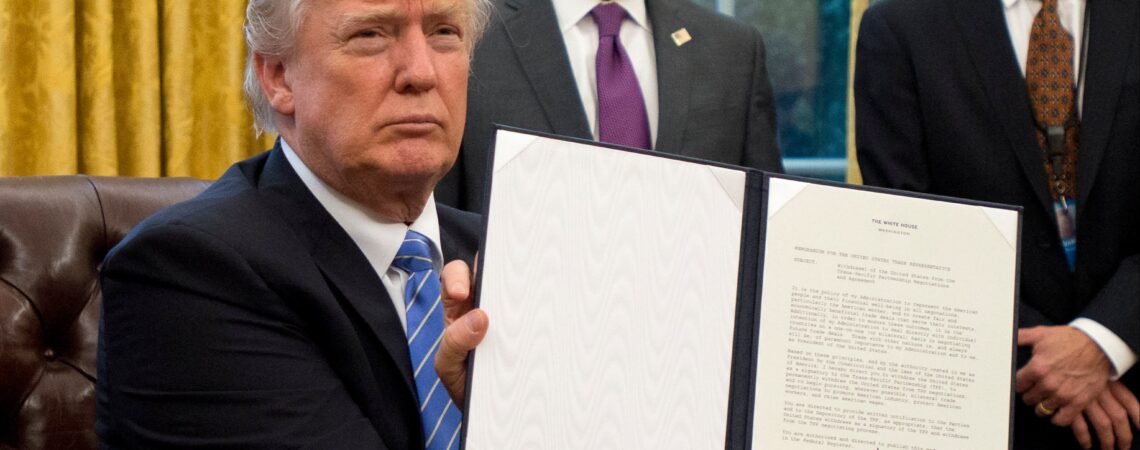In mid-September, Liz Truss, the International Trade Secretary for the United Kingdom, met with the 11 members of the Comprehensive and Progressive Agreement for Trans-Pacific Partnership, or CPTPP, to discuss potential British accession.
London characterized the meeting as “a major step in the process of joining” the regional trade deal, and the U.K. now seems on track to become the first country to do so. Could the U.S. follow suit under a Joe Biden administration or a second Donald Trump term?
If the U.S. were to seek to rejoin the trade deal, it would admittedly be a stunning reversal. After all, in 2016 both presidential candidates criticized the Trans-Pacific Partnership, the deal’s predecessor. President Trump went further as soon as he took office by withdrawing the U.S. from the TPP, contending that bilateral trade deals were the way to go. Yet, the case for the U.S. participation is more compelling than ever.
Joining the CPTPP would be a sure way to deepen strategic and economic ties to Asia, a region that has become the engine for global growth, and that is projected to account for 50% of the global economy by 2040. The COVID-19 pandemic has only accelerated that trend as East Asia is already bouncing back from the resulting economic slump faster than the rest of the world.
The COVID-19 crisis has also highlighted vulnerabilities in supply chain networks for critical and strategic sectors from medical supplies to semiconductors. Given that reshoring all production in those sectors is not feasible, establishing supply chains with trusted partners is an important alternative to enhance resiliency in these networks. The CPTPP, which lays out common rules and standards to facilitate the movement of goods and services between members, can serve as the basis for trusted supply chains in the region.
Finally, participation in the CPTPP would provide an important boost to U.S. strategy on China. The Trump administration’s go it alone approach, including unilateral tariff hikes and bilateral negotiations, has had limited success in reining in China’s unfair trade practices. Joining the CPTPP would give Washington an opportunity to work with like-minded countries to promote an alternative economic model to Beijing’s state-led capitalism.
While neither Biden nor Trump have said they would seek to join the CPTPP, both have expressed support for the idea at different points. Biden supported the TPP as vice president and he has more recently stressed the importance for the U.S. to write the rules of the road on trade. Candidate Trump vehemently denounced the TPP in 2016, but in 2018, as president, he suggested that the U.S. could join the CPTPP before saying that it would take a major renegotiation.
What would be the path for the U.S. to join? As described in a new Asia Society Policy Institute report, a major renegotiation as suggested by President Trump would likely be out of the question. While the U.S. would seek changes to reflect the evolution in technologies and U.S. trade policy similar to those included in the United States-Mexico-Canada Agreement, there is little appetite for sweeping changes among member countries. Many of those governments expended significant political capital on the original TPP negotiations and still feel scarred by the abrupt U.S. departure.
On the other hand, the formal accession process, where the interested candidate is largely expected to accept the rules in place, is not appropriate, as the U.S. economy is larger than the combined economies of all other members. Some sort of middle ground would need to be found where the U.S. would focus on the most critical changes it would seek, and the CPTPP members would remain more flexible to welcoming revisions than during a more traditional accession.
Still, the U.S. has some work to do at home before it could be ready to join the CPTPP. This work includes consultations with Congress and other domestic stakeholders, such as business, labor, and civil society groups on what the U.S. trade agenda should look like. It would also need to invest in policies to boost U.S. competitiveness and innovation while providing meaningful and robust worker adjustment programs.
But this does not mean that the U.S. needs to wait to reengage on trade with the Asia-Pacific. The White House could pursue a narrower deal with the CPTPP countries first around a timely negotiating topic such as digital trade, the environment, and climate if Biden wins the election or trade in medical and other essential products. A sectoral deal would help build trust and serve as a starting point for U.S. reentry down the road.
It is fair to question whether rejoining is worth it, particularly given the opposition that the TPP faced only four years ago. Yet, with trade driving so much of both economic growth and regional economic alignment, reengaging the members of the CPTPP is one of the most impactful ways in which the president can help shape the future of the region.
Doing so would help propel the U.S. economic recovery, and provide a platform to work with like-minded countries to promote an alternative to China’s state-led economic model. The U.K., a world away from the Pacific, sees the CPTPP as an opportunity to “boost our economic security” and “reshape global trading rules alongside countries who share our values.” The winner of the 2020 election should as well.
Wendy Cutler is vice president at the Asia Society Policy Institute. She is a former Acting Deputy U.S. Trade Representative, where she had responsibility for the Trans-Pacific Partnership agreement.
To view the original post, please click here.

